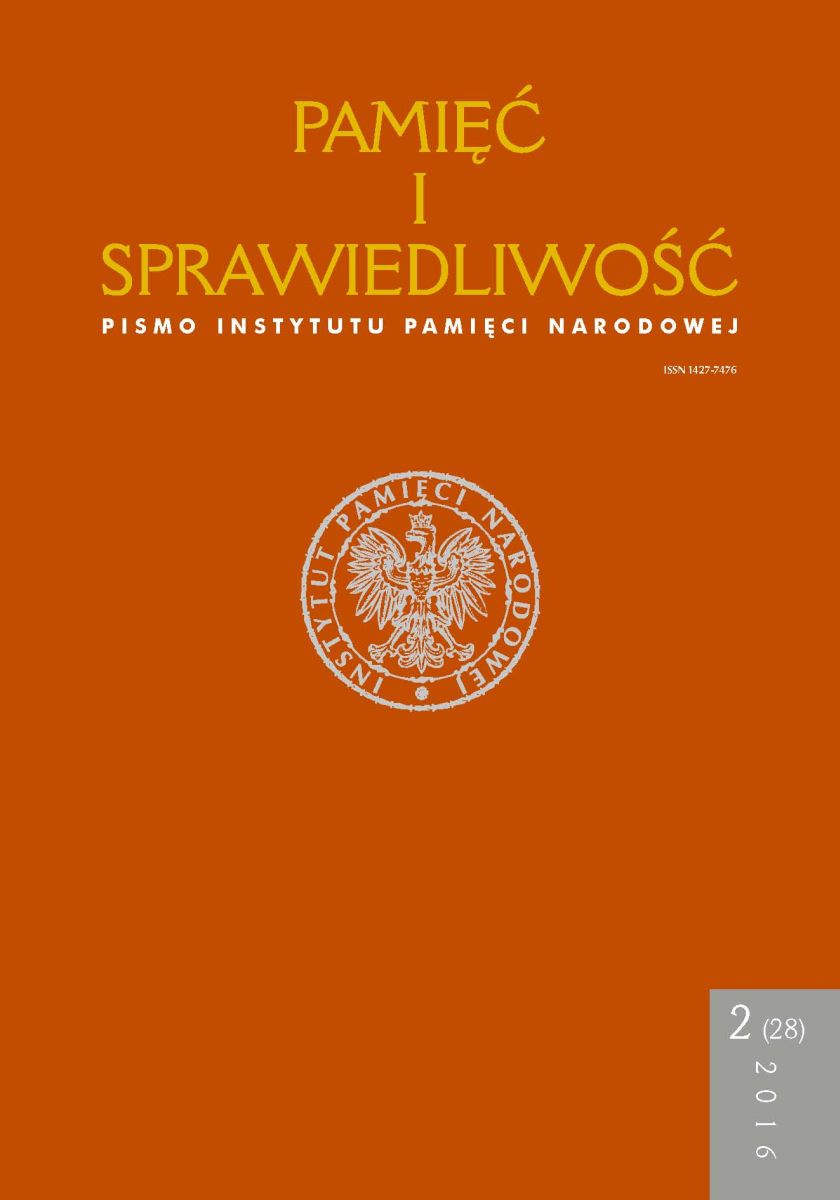1956 - instytucje i dynamika represji porewolucyjnyhc
Pamięć i Sprawiedliwość, Том 28 № 2 (2016), pages: 373-394
Publication date: 2016-06-30
Аннотация
Библиографические ссылки
M. Baráth, A Kreml árnyékában. Tanulmányok Magyarország és a Szovjetunió kapcsolatainak történetéhez, 1944–1990, Budapest 2014,
M. Baráth, A politikai rendőrség újjászervezése 1956 után, „Történelmi Szemle” 2008, nr 4, s. 535–563,
Cs. Békés, Cold War, Détente and the 1956 Hungarian Revolution, „Working paper” No. 7, 2002, Project on the Cold War as Global Conflict, International Center for Advanced Studies. New York University (http://coldwar.hu/html/en/publications/detente.pdf, dostęp: 8 V 2016),
The 1956 Hungarian Revolution. A History in Documents, red. Cs. Békés i in., Budapest – New York 2002
L. Borhi, In the Power Arena. US-Hungarian Relations, 1942–1989, „The Hungarian Quarterly” 2010, vol. 51, nr 198, s. 71–81.
L. Eörsi, Tóth Ilona [w:] idem, Mítoszok helyett – 1956, Budapest 2003,
L. Eörsi, Köztársaság tér, 1956, Budapest 2006,
L. Eörsi, Koncepciós mítoszrombolás, II, „Beszélő” 2010, t. 15, nr 2–3, s. 82–84,
J. Granville, The First Domino. International Decision Making during the Hungarian Crisis of 1956, College Station 2004,
T. Huszár, A hatalmi gépezet újjáépítése, a represszió túlsúlya, a kiigazítás esélye; 1956–1960 [w:] Restauráció vagy kiigazítás. A kádári represszió intézményesülése, 1956–1962, red. T. Huszár, J. Szabó, Budapest 1999, s. 67–146,
Á. Nagy-Csere, Munkásokból huligánok. A huligán mint társadalmi kategória megteremtése 1956 állambiztonsági értelmezésében, Betekintő 2009 (http://www.betekinto.hu/2009_4_nagy_csere; dostęp: 8.05.2016);
S. Horváth, Az erőszak államosítása és a kollektivizálás – kutatási problémák és keretek [w:] Állami erőszak és kollektivizálás a kommunista diktatúrában, red. S. Horváth, J.Ö. Kovács, s. 13–18.
M. Horváth, Losses of Life in the War and during the Reprisals [w:] 1956. The Hungarian Revolution and War for Independence, red. L. Congdon i in., Boulder, Colorado/Highland Lakes 2006, s. 477–492
F. Kahler, Joghalál Magyarországon, 1945–1989, Budapest 1993
F. Kahler, S.M. Kiss, Kinek a forradalma?, Budapest 1997,
F. Kahler, S.M. Kiss, Mától kezdve lövünk” – 10 év után a sortüzekről, Budapest 2003,
R. Kiss, S.M. Kiss, A csalogány elszállt. Tóth Ilona tragikuma, Budapest, 2007,
S.M. Kiss, Közelítések, 1956. Tanulmányok, esszék, előadások, Budapest 2011,
Ö. Kovács, A paraszti társadalom felszámolása a kommunista diktatúrában. A vidéki Magyarország politikai társadalomtörténete, 1945–1965, Budapest 2012,
Zs. Krahulcsán, A párt belügye. A politikaim rendőrség és az MSZMP a korai Kádár-korszakban (1956–1962), Budapest 2013,
Zs. Mikó, A Legfelsőbb Bíróság Népbírósági Tanácsa működése és ügykezelési gyakorlata (1957–1963), Budapest 2012, s. 105 (praca doktorska: http://doktori.btk.elte.hu/hist/mikozsuzsanna/diss.pdf; dostęp: 8.05.2016),
A MSZMP ideiglenes vezető testületeinek jegyzőkönyvei I. 1956. november 11.-1957.
Január 14., red. V.K. Némethné, L. Sipos, Budapest 1993,
A MSZMP ideiglenes vezető testületeinek jegyzőkönyvei. II. köt. 1957. január 25–1957. április 2., red. K.V. Némethné, K. Urbán, Budapest 1993,
J.M. Rainer, The Reprisals, „New Hungarian Quarterly” 1992, R. XXXIII, nr 127, s. 118–127;
J.M. Rainer, Imre Nagy. A Biography, London 2008
A. Szakolczai, A fegyveres erőszakszervek restaurálása 1956–1957 fordulóján [w:] Évkönyv 1999, vol. VII, (Magyarország a jelenkorban), red. É. Standeisky, J.M. Rainer, Budapest 1999, s. 18–60,
A. Szakolczai, Repression and Restoration, 1956–1963 [w:] The Ideas of the Hungarian Revolution. Suppressed and Victorious, 1956–1999, red. L. Congdon, B. Király, Boulder, Colorado 2002, s. 167–193
A. Szakolczai, Népköztársaság tér, 2006 (http:// www.rev.hu/rev/htdocs/hu/tanulmanyok/1956/nepkoztarsasagter_sza.pdf; dostęp: 8 V 2016) 2007,
A. Szakolczai, Szegény Jankó Piroska [w:] Közelítések a kádárizmushoz. Évkönyv, XV, red. P. Germuska, J.M. Rainer, Budapest 2008,
A. Szakolczai, A Tóth Ilona és társai per komplex vizsgálata (praca doktorska; http://www.idi.btk.pte.hu/dokumentumok/disszertaciok/szakolczaiattilaphd.pdf; dostęp: 8 V 2016)
T. Takács, Szövegek, tények, stratégiák. A történelem és forrásai, „BUKSZ” 2008, t. 20, nr 4, s. 361,
É.Tulipán, Szigorúan ellenőrzött emlékezet. A Köztársaság téri ostrom 1956-ban, Budapest 2012, s. 14–21,
T. Zinner, A kádári megtorlás rendszere, Budapest 2001
T. Zinner, Utak és tévutak a XX. Századi magyar felsőbíráskodás káderpolitikájában’56 után [w:] A Kúria és elnökei III, red. K. Bódiné Beliznai, Budapest 2015
 Język Polski
Język Polski
 English
English
 Deutsch
Deutsch
 Français (France)
Français (France)
 Italiano
Italiano
 Русский
Русский


 PDF (Język Polski)
PDF (Język Polski)
